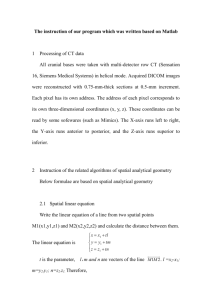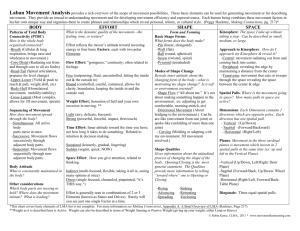PH 481 Physical Optics Winter 2012
advertisement
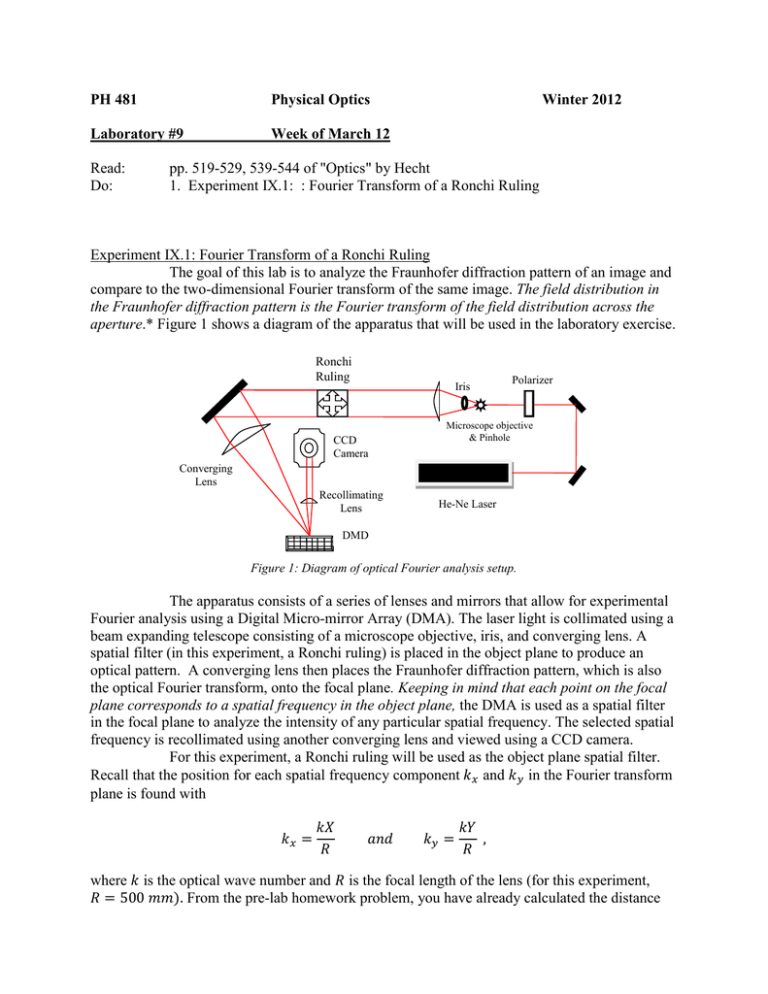
PH 481 Physical Optics Laboratory #9 Week of March 12 Read: Do: Winter 2012 pp. 519-529, 539-544 of "Optics" by Hecht 1. Experiment IX.1: : Fourier Transform of a Ronchi Ruling Experiment IX.1: Fourier Transform of a Ronchi Ruling The goal of this lab is to analyze the Fraunhofer diffraction pattern of an image and compare to the two-dimensional Fourier transform of the same image. The field distribution in the Fraunhofer diffraction pattern is the Fourier transform of the field distribution across the aperture.* Figure 1 shows a diagram of the apparatus that will be used in the laboratory exercise. Ronchi Ruling CCD Camera Iris Polarizer Microscope objective & Pinhole Converging Lens Recollimating Lens He-Ne Laser DMD Figure 1: Diagram of optical Fourier analysis setup. The apparatus consists of a series of lenses and mirrors that allow for experimental Fourier analysis using a Digital Micro-mirror Array (DMA). The laser light is collimated using a beam expanding telescope consisting of a microscope objective, iris, and converging lens. A spatial filter (in this experiment, a Ronchi ruling) is placed in the object plane to produce an optical pattern. A converging lens then places the Fraunhofer diffraction pattern, which is also the optical Fourier transform, onto the focal plane. Keeping in mind that each point on the focal plane corresponds to a spatial frequency in the object plane, the DMA is used as a spatial filter in the focal plane to analyze the intensity of any particular spatial frequency. The selected spatial frequency is recollimated using another converging lens and viewed using a CCD camera. For this experiment, a Ronchi ruling will be used as the object plane spatial filter. Recall that the position for each spatial frequency component and in the Fourier transform plane is found with where is the optical wave number and is the focal length of the lens (for this experiment, From the pre-lab homework problem, you have already calculated the distance for each intensity maxima in the viewing plane; use the separation of each mirror on the DMA ( ) to find the distance of each intensity maxima from the DMA’s center in pixels. Now that we have found the location of each intensity maxima on the DMA, we seek to measure the intensity of each maxima experimentally. The correct spatial filter must be selected to transmit the desired spatial frequency component. In the D4100 GUI, Click the “Load” tab on the left and press “open image.” A library of usable spatial filters is now available to you; you may choose to use either an annuli, two dots, or two horizontal bars as your filter shape. Which shape did you choose and why? First, select the “all-black” image. This will transmit all light incident on the DMA to the CCD camera. In the “load” tab, choose “load and reset” and “global” as the loading arguments and click “Add.” Click the “control” tab and add a delay time command of ~5000 ms. Click the “run” button in the top control bar to run the script. Open the IC Capture software and take a picture. Save the image; this will be used as a reference to the individual spatial frequency intensities. We will now experimentally measure the intensity of each frequency component produced by the Ronchi ruling using the DMA. Using your calculated spatial frequency locations, repeat the above process with a new image that will transmit only the zero harmonic in the focal plane (that is, the central bright spot of the Fourier transform). How does the image produced by the zeroth order harmonic filter differ from that produced by the all-transmitting filter? Repeat the process for next three neighboring spatial frequency components in the Fourier transform plane. Be sure to save images for each spatial frequency! We will now open the images for each spatial frequency and analyze the maximum intensity using ImageJ. First, open the image of the zeroth order harmonic and use the “analyze” feature to determine the maximum intensity measured by the CCD. Repeat this operation with each image collected for the spatial frequencies. Plot the intensity as a function of spatial frequency ( . How do the relative values compare with the max amplitudes predicted in the theoretical model? NOTE: Our diagram should state explicitly where the Focal plane and Object plane are in our experimental setup. Equipment needed: Item Helium-Neon Laser Al mirror Polarizer 200 mm lens 500 mm lens 150 mm lens Magnetic Lens Post Mounting posts Translation Stage Iris Ronchi Ruling Digital Micromirror D. CCD Camera Power supply Qty 1 3 1 2 1 1 1 8 2 1 1 1 1 1 Source (part #) Melles Griot 05 LHP 121 Newport 10D10ER.1 Edmund A38,396 Newport KPX106 Newport KPX118 Newport KPX100 Newport MB-2 Thor Labs P3 Newport 423 Newport Texas Instruments Imaging Center DMK21AU04 Uniphase 1205 Pre-Lab Homework Problem A planar electric field filtered with a Ronchi ruling is functionally represented in the object plane as a series of rectangle functions of the form ( ∑ ( ( ) where a is the width of the rectangle, is the number of transmitting bars in the ruling, and is the center of each bar as shown in Figure 1. 𝑥 𝑎𝑁 𝑎𝑁 𝑎𝑛 𝑎𝑁 𝑎 Figure 1: Diagram of a Ronchi ruling. a. Compute the spatial Fourier transform of the electric field in the object plane. b. Find the intensity ( of the electric field resulting from the Fourier transform. Compare this solution to the intensity pattern produced by multiple slits in the Fraunhofer regime after making the change of variables where is the position in the viewing plane and is the distance between the object plane and the point in the viewing plane (Note: recall that . c. Sketch the intensity pattern for N=4 as a function of . d. Using your answer from part b) find the position of the first four maxima when e. Find the ratio between the central maximum intensity and each of the next three maximum intensities. Solution Data: 1000 Theoretical 900 Intensity (# photons/pixel) 800 Average Intensities 700 600 Average Local Intensities 500 400 Theoretical Local 300 200 100 0 -100 0 500 1000 1500 2000 2500 3000 3500 Distance from Center (µm) Figure 1: This is an average of the data that was found experimentally. The difference in theoretical data and experimental should be explained using apodization.
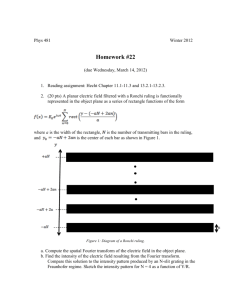
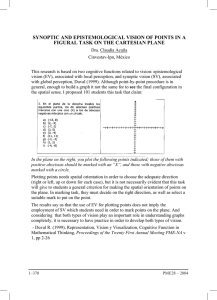
![The University of British Columbia 1. [10] Find all values of:](http://s2.studylib.net/store/data/011109874_1-dc7979817b8d8d5f7c87a2a1e3d190f9-300x300.png)



